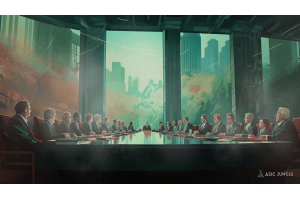Exploring the Inner Workings of Bitcoin Tokens and a Decentralized Protocol for Ordinal Collection Verification
Classified as a commodity, one might think the Bitcoin community would be in a state of Zen, singing “Kumbaya.” However, an update to the Bitcoin blockchain has sparked controversy over the past few months.
Some would compare it to the 2017 Segwit saga. Pepe memes are blocking the network as the community faces internal ructions about whether Bitcoin should give space for permissionless NFTs.
Bitcoin Ordinals, popularly referred to as Bitcoin NFTs, the latest development in the original blockchain ecosystem, is the source of this drama. With the first Ordinal minted in December 2022, in less than six months, almost 5 million Ordinal inscriptions are clogging up the mempool and driving network fees through the roof.
Suffice it to say Bitcoin’s base layer has hit a bump in the road, and the community stands divided. Without getting tangled in the technical weeds, this article discusses the latest developments on the Bitcoin base layer, explores why jpegs are jamming up the mempool, and how Ordinals originated. Finally, we dive into BRC20 tokens, what BRC-721 is all about, and what the future of Bitcoin may look like.
JPEGs jamming up the mempool
As of May 2023, the Bitcoin mempool (short for memory pool) currently has 400 000 plus unprocessed transactions. The network fees for a single transaction stand at around $10, and the total number of daily transactions has reached an all-time high.
Due to congestion issues and the large volume of pending transactions, Binance halted Bitcoin withdrawals. Soon after, they announced they are working to enable BTC Lightning Network withdrawals, which will help to prevent a similar recurrence in the future.
Meanwhile, the Crypto Twitter community echoed conflicting sentiments about the unusual activity. One camp maintained that the hyperactivity was due to nefarious behavior, spamming the blockchain to cut out small players. Others blamed the rise of meme coins and the popularity of the Ordinals protocol for driving the demand for block space.
How did the Ordinals originate?
Inspired by the Ethereum NFT craze in 2021, Casey Rodarmor, a former Bitcoin developer and artist, inscribed the first Bitcoin Ordinal in December 2022. He created a black-and-white pixel artwork of a skull and embedded it on the Bitcoin blockchain using Taproot. Later in January 2023, he launched the Ordinal Theory Handbook, a guide to help other users build NFTs on the Bitcoin blockchain.
Rodarmor devised a framework for indexing and tracking each satoshi on the Bitcoin blockchain. In addition, he created a method for inserting each one with media, such as text, video, or jpegs, to create what he called 'Bitcoin-native digital artifacts.' This gave inscribed satoshis, Ordinals, NFT-like properties. Their unique identifiers made them non-fungible and they could be held in Bitcoin wallets, being transferred using Bitcoin transactions.
Launching the Ordinal protocol did not require a sidechain, token, or drastic Bitcoin improvement proposal (BIP) to augment the network. His idea was to create content inscriptions, or NFT artwork, that benefit from the existing characteristics of the protocol, which had been boosted by the relatively recent SegWit and Taproot upgrades.
Rodarmor seemingly injected some fun into Bitcoin. Ordinals swept the NFT community by storm in just a few months due to its simplicity and accessibility.
BRC20 tokens
Building from the success of Ordinals, a pseudonymous on-chain analyst named Domo created Bitcoin Request for Comment (BRC-20) tokens using the Ordinals protocol. In early March 2023, Domo conducted a 'fun experiment' demonstrating that users can create fungible tokens on the Bitcoin blockchain using the Ordinals protocol.
The name 'BRC-20' is inspired by Ethereum's ERC-20 token standard. As its name suggests, it aims to compete with the ERC-20 Fungible Token Standard, with core features including token deployment, minting, and transfer. However, although BRC-20 tokens are gaining popularity, they are far from perfect and do not have anywhere as many features as their advanced counterpart.
Even Domos admitted that his Bitcoin Fungible Token Protocol, BRC-20, still required a lot of work and should not remain as a blueprint for Bitcoin tokens of the future.
What is the BRC-721 proposal?
The Bitcoin Ordinal ecosystem has been facing challenges with standardization in collection creation and verification. Currently, Bitcoin Ordinals lack a standardized method for grouping items into collections, as this relies on specific, often centralized, services and wallets.
BRC-721, also called the Ordinals Collection Protocol, is under development by Poyo, a pseudonymous developer. Inspired by Ethereum's ERC-721 standard for NFTs, BRC-721 aims to provide a decentralized method for creating and verifying collections.
The protocol eliminates the need for upfront payments, streamlines the process, and enhances overall security and reliability through verification rules and a manifest data structure. The BRC-721 protocol offers advantages, such as a more secure and robust ecosystem, enhanced security, a streamlined process, and proven success.
Varying views
The crypto investment firm, Grayscale, believes Ordinals are an overall positive for the Bitcoin network in two key ways. The first is that the increase in Bitcoin transaction fees helps miners earn fees. Second, the rise of NFTs on Bitcoin contributes to a cultural transformation within the community, a so-called “cultural layer” of the Bitcoin network.
Adam Black, CEO of Blockstream, also commented. He acknowledged that Bitcoin is censorship resistant and that the Ordinals Protocol is unstoppable. Black tweeted, “[It] doesn't stop us from mildly commenting on the sheer waste and stupidity of an encoding. At least do something efficient. Otherwise, it's another proof of the consumption of block-space thingy.”
Michael Saylor seems to accept the inevitability of rising transaction fees. When asked about Ordinals, he indicated that the resulting spike in on-chain transaction fees is a short-term sign of a long-term trend. He continued by stating that, “this is going to definitely catalyze the development of layer 2’s and 3’s, no doubt”, arguing that there’s no reason why anyone should want to wait 30 minutes for a transaction when the Lightning Network can process it immediately.
One might argue that Bitcoin’s base layer is not an efficient or cost-effective method for storing large amounts of data. After all, according to Satoshi, the primary purpose of Bitcoin is to record and verify financial transactions, not arbitrary memes. While it is possible to encode small amounts of data into Bitcoin transactions by embedding data in the transaction's outputs, it generally has not been advisable because it can cause congestion issues in the mempool and higher fees.
CryptoKitties moment
Some have compared the Ordinals saga to the CryptoKitties Congestion Saga. CryptoKitties, much like Ordinals, launched as a playful experiment. However, when the game became viral, the prices reached six figures, and gained mainstream media coverage. The game's popularity caused a surge in transactions on the Ethereum network, causing concerns about the network's ability to handle the traffic.
A new era for Bitcoin
The introduction of Bitcoin Ordinals has created controversy within the Bitcoin community. Their exceeding popularity, along with BRC-20 tokens, has led to undeniable congestion issues in the Bitcoin mempool.
Despite a variety of views, the rise of this new era seems to be benefitting the Bitcoin network in terms of growing development activity and “cultural” engagement. Regardless of lasting outcomes, Ordinals are being inscribed on the base layer of Bitcoin, and that will likely never change.
What are your thoughts on the Ordinals conversation? Be sure to tune into the latest coverage of the Bitcoin 2023 Miami conference where Ordinals are expected to be a hot topic. With Asic Jungle in attendance, Bitcoin mining will also be garnering special attention amongst the drama of Ordinals.






